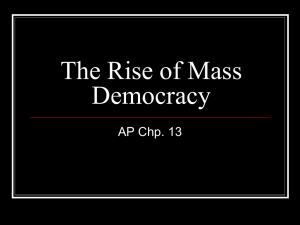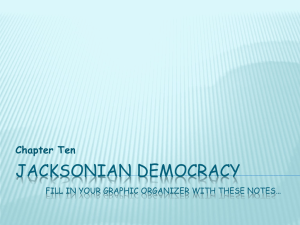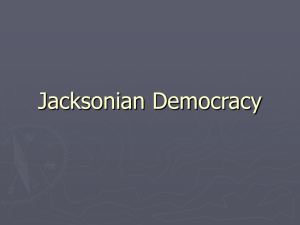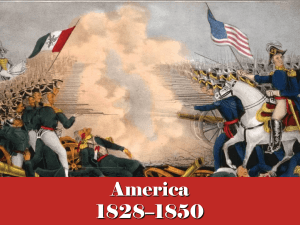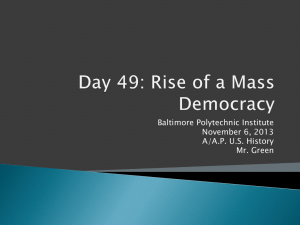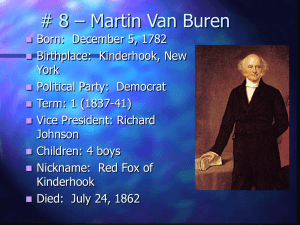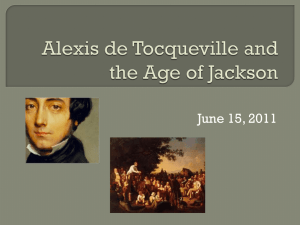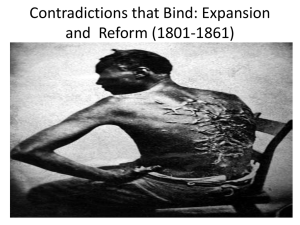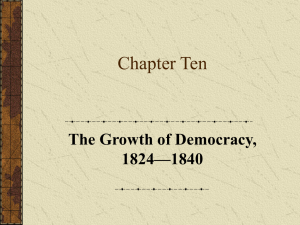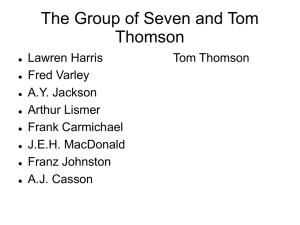Mur_Con12
advertisement
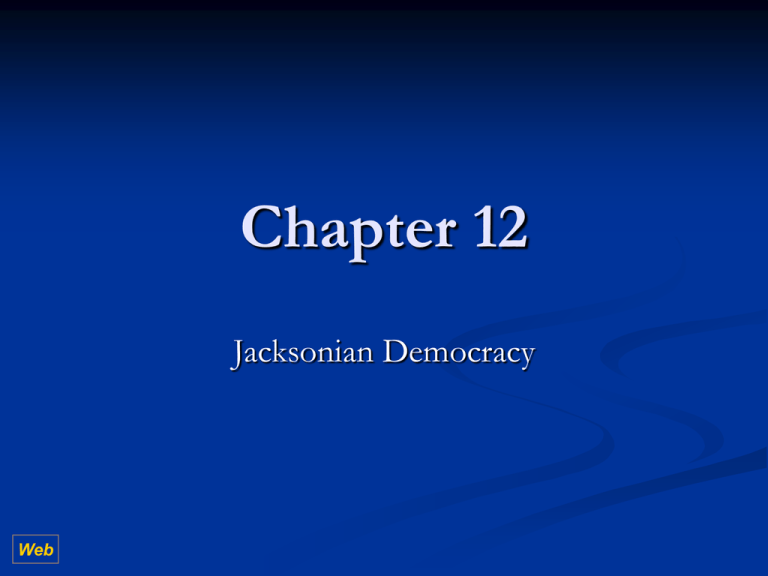
Chapter 12 Jacksonian Democracy Web Origins of Jacksonian Democracy Debate in 1819 over Missouri Rooted in 1803 Louisiana Purchase Slavery tied to Missouri Petition for statehood Debate over sectional power, not morality of slavery Compromise, 1820 Maine admitted as free state (carved out of Massachusetts) Missouri admitted as slave state Slavery outlawed from Missouri’s southern border northward Origins of Jacksonian Democracy (cont.) Opened Arkansas to slavery, outlawed it everywhere else in Louisiana Purchase Laid bare different sectional ideas about slavery in the territories Panic of 1819 Multitude of international causes Hit cities and countryside both Fed public opposition to banks Development in National Politics Jeffersonians had lost their way after 1816 Abandoned ideas of small-government and states’ rights Crises of 1819 and 1820 prompted a return to the party’s principles Role of Martin van Buren in creating Democratic Party Election of 1824 Four-way race that broke back of the Republican Party John Quincy Adams and John C. Calhoun elected Charges of a corrupt bargain between John Quincy Adams and Henry Clay Andrew Jackson vowed to get revenge and return majority rule to politics ©2004 Wadsworth, a division of Thomson Learning, Inc. Thomson Learning™ is a trademark used herein under license. Presidential Election, 1824 John Quincy Adams in the White House Foreign policy successes as secretary of state Rush-Bagot Treaty, 1817 British-American Convention of 1818 Adams-Onis Treaty, 1819 Monroe Doctrine, 1823 Goal at home was an ambitious nationalist program Expansion of government power and action Nothing accomplished Politically, did little to prepare for election of 1828 Election of 1828 Clear from 1825 it would pit Adams against Jackson Van Buren backed Jackson and helped to create the new Democratic Party States rights, limited government agenda of the Jeffersonians Linked popular democracy with a defense of slavery Unite southern planters with northern plain folk Election of 1828 (cont.) Campaign was an exercise in slander Voter turnout double that of 1824 Big win for Jackson Common people turned out to celebrate Jackson’s inauguration in March 1829 Inaugural address a vague endorsement of Democratic principles Van Buren as secretary of state Other appointments not as promising Led to furor over spoils system and use of ©2004 Wadsworth, a division of Thomson Learning, Inc. Thomson Learning™ is a trademark used herein under license. Presidential Election 1828 Jacksonian Democracy and the South Staunchest support for Jackson in 1828 Debate in administration over how best to protect the region Vice President Calhoun favored concept of states’ rights Secretary of State Van Buren believed the Union was inviolable and that the South could best be protected by8 a strong democratic Party Disagreement set stage for confrontation of who would succeed Jackson The South and the Indian Question “Civilized Tribes” still had large presence in Old Southwest by the 1820s Southern whites resented Indians’ presence and wanted control of their land Recognized as sovereign peoples by Congress and Treaties Also raised question of states’ rights Struggle in Georgia between state government and the Cherokees The South and the Indian Question (cont.) Indian removal Act of 1830 would move Cherokees to federal land west of Mississippi Supreme Court intervention Cherokee Nation v. Georgia, 1830 Worcester v. Georgia, 1832 Indians as “domestic dependent nations” Banned Georgia’s extension of state law into Cherokee land Jackson refused to obey States continued to encroach on Civilized Tribes Trail of Tears in 1838 complete removal The South and the Tariff Tariff of 1828, designed to win votes for Jackson in Old Northwest and Middle Atlantic, worried the South South Carolina took lead in opposition Denounced by Southern legislatures Spoke of nullification and made states’ rights arguments Pressure on Jackson to make modifications Tariff of 1832 reduced rates but kept tariff in place Led South Carolina to nullify Tariffs of 1828 and 1832 both Jackson refused to accept nullification The “Petticoat Wars” Involved Secretary of War John Henry Eaton and his wife, Peggy Split the administration, and Washington high society Entire Cabinet, save Secretary of State Van Buren, shunned the Eatons Opposition headed by Vice President Calhoun Enraged Jackson, who purged the offenders and made Peggy Eaton his official hostess in the White House Power struggle between Calhoun and Van Buren resulted in latter’s choice as vice president in 1832 Van Buren then became Jackson’s chosen successor Jackson came to rely increasingly on informal “Kitchen Growing Controversy over Slavery Evangelicals adopted postal campaign in 1835 Began petition campaign in 1836 Bombarded Congress with antislavery petitions Disagreement in Jackson administration about proper response Flooded mail with antislavery tracts Postal campaign thwarted through state censorship without federal interference Gag rule on petitions as Congress chose to table them without a reading Reflected Democrats’ efforts to protect southern slavery while ensuring the inviolability of the federal Jacksonian Democracy and the Market Revolution Battle over appropriate governmental role in economy Second Bank of the United States became focus of dispute Exercised control over nation’s monetary and credit system Supported by Businessmen, distrusted by public Jackson saw as concentration of power that threatened the republic Jacksonian Democracy and the Market Revolution (cont.) Jackson’s opponents tried to engineer crisis by applying for Bank’s re-charter four years early Jackson vetoed, with message that served as manifesto for Jacksonian Democracy Tried to use veto against Jackson in presidential campaign of 1832 Backfired, as public supported Jackson After winning re-election, Jackson removed federal deposits from Bank Took three treasury secretaries before he found one willing to assent Essentially destroyed Bank ©2004 Wadsworth, a division of Thomson Learning, Inc. Thomson Learning™ is a trademark used herein under license. Presidential Election, 1832 Origin of the Whig Party Opposed to Jackson’s perceived “executive usurpation” Core of old National Republican coalition became new Whig Party Bank War Over-use of veto Spoils system Joined by southerners upset at Jackson’s opposition to nullification Continued partisan disagreement on the economy Governmental surplus demanded federal attention Deposit Act (1836) increased number of banks receiving federal deposits Specie Circular (1836) set rules for purchase of federal lands with specie and banknotes The Second American Party System Whigs ran sectionally based campaigns in 1836 Democrats ran a united front behind Martin van Buren Panic of 18377 hit just after van Buren took office Whigs believed they had good chance to win in 21840 Almost all segments of the economy hurt Commercial and export sectors suffered most Administration sought Independent Treasury as solution Whigs scored big gains in mid-term elections in 1838 Blamed Van Buren for Panic Sought to build consensus by nominating William Henry Harrison Whig victory completed creation of second American ©2004 Wadsworth, a division of Thomson Learning, Inc. Thomson Learning ™ is a trademark used herein under license. Presidential Election , 1836 Web ©2004 Wadsworth, a division of Thomson Learning, Inc. Thomson Learning ™ is a trademark used herein under license. Presidential Election, 1840
